Wilko HRM: Employee Engagement, Communication, and Training
VerifiedAdded on 2023/06/12
|13
|4114
|434
Report
AI Summary
This report analyzes Human Resource Management (HRM) strategies at Wilko, a British retail chain, focusing on enhancing employee engagement and involvement. It discusses techniques like team-building workshops, continuous feedback, performance appraisals, and creating a welcoming environment to improve employee relations and productivity. The report also examines the application of Maslow's hierarchy of needs and Kahn's model to motivate and engage employees by addressing their psychological needs. Furthermore, it explores communication approaches, including verbal, non-verbal, and visual methods, emphasizing the importance of open communication and feedback. The report also touches upon communication theories like bureaucracy and general system theory and highlights the significance of training and development programs for both managers and employees to enhance their skills and knowledge. The document is available on Desklib, a platform providing study tools for students.
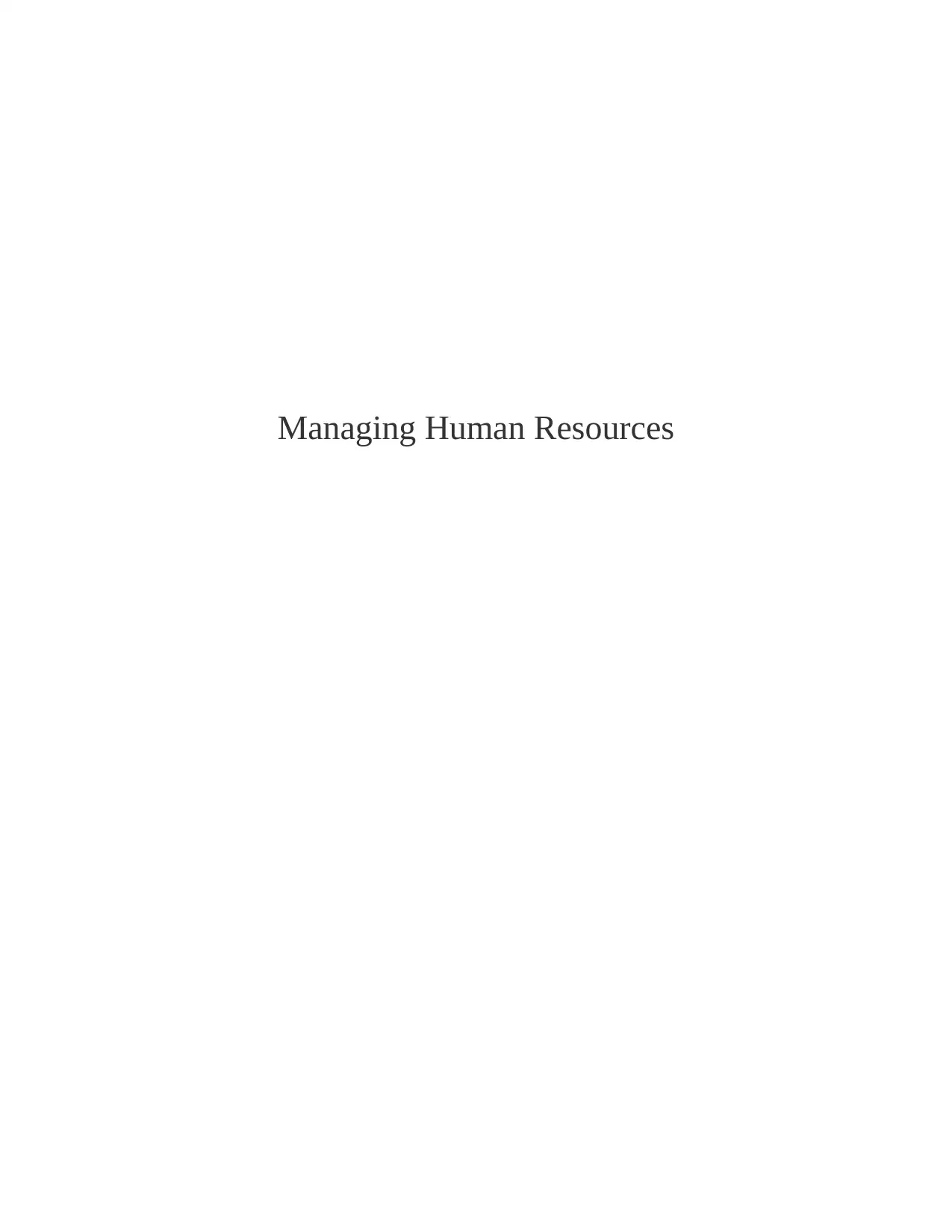
Managing Human Resources
Paraphrase This Document
Need a fresh take? Get an instant paraphrase of this document with our AI Paraphraser
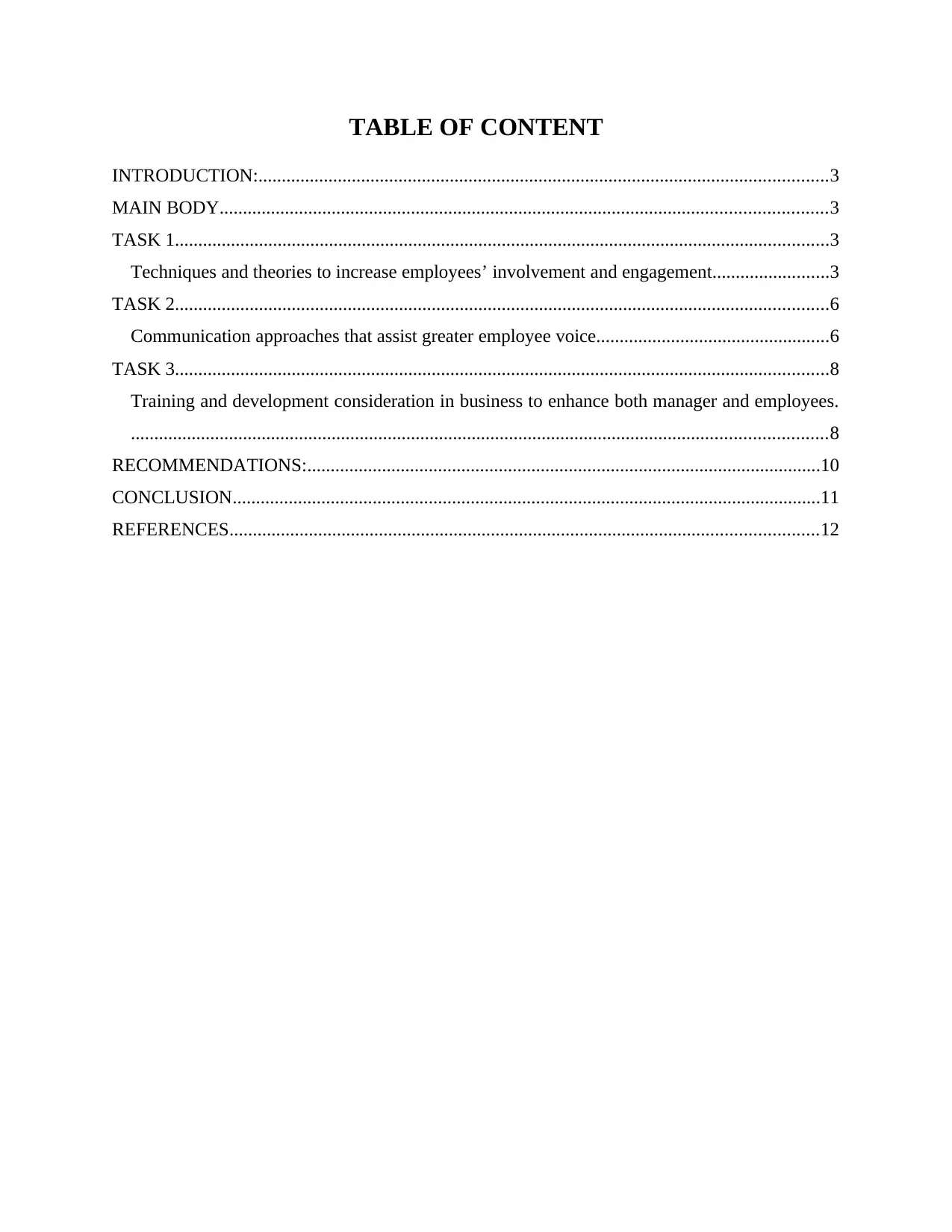
TABLE OF CONTENT
INTRODUCTION:..........................................................................................................................3
MAIN BODY..................................................................................................................................3
TASK 1............................................................................................................................................3
Techniques and theories to increase employees’ involvement and engagement.........................3
TASK 2............................................................................................................................................6
Communication approaches that assist greater employee voice..................................................6
TASK 3............................................................................................................................................8
Training and development consideration in business to enhance both manager and employees.
.....................................................................................................................................................8
RECOMMENDATIONS:..............................................................................................................10
CONCLUSION..............................................................................................................................11
REFERENCES..............................................................................................................................12
INTRODUCTION:..........................................................................................................................3
MAIN BODY..................................................................................................................................3
TASK 1............................................................................................................................................3
Techniques and theories to increase employees’ involvement and engagement.........................3
TASK 2............................................................................................................................................6
Communication approaches that assist greater employee voice..................................................6
TASK 3............................................................................................................................................8
Training and development consideration in business to enhance both manager and employees.
.....................................................................................................................................................8
RECOMMENDATIONS:..............................................................................................................10
CONCLUSION..............................................................................................................................11
REFERENCES..............................................................................................................................12
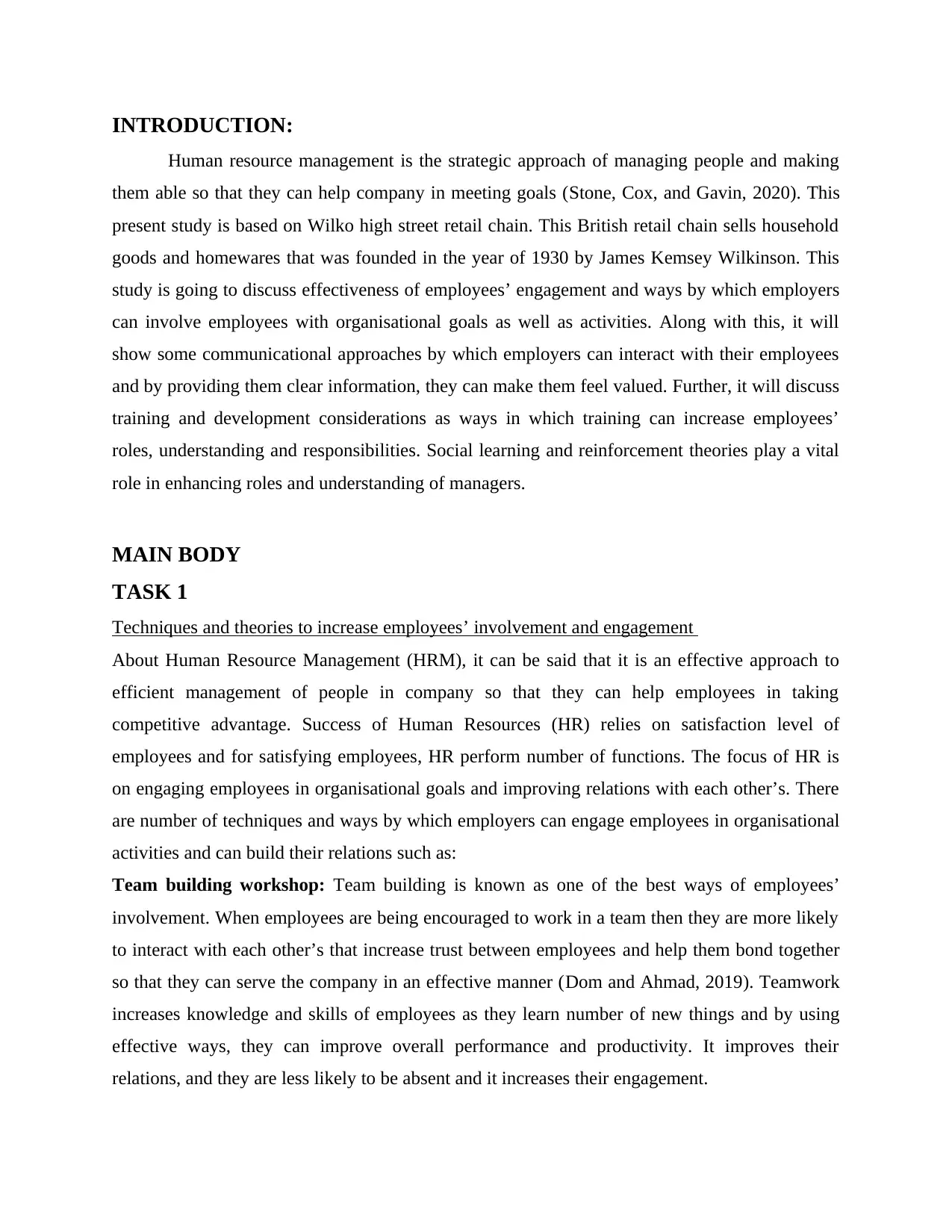
INTRODUCTION:
Human resource management is the strategic approach of managing people and making
them able so that they can help company in meeting goals (Stone, Cox, and Gavin, 2020). This
present study is based on Wilko high street retail chain. This British retail chain sells household
goods and homewares that was founded in the year of 1930 by James Kemsey Wilkinson. This
study is going to discuss effectiveness of employees’ engagement and ways by which employers
can involve employees with organisational goals as well as activities. Along with this, it will
show some communicational approaches by which employers can interact with their employees
and by providing them clear information, they can make them feel valued. Further, it will discuss
training and development considerations as ways in which training can increase employees’
roles, understanding and responsibilities. Social learning and reinforcement theories play a vital
role in enhancing roles and understanding of managers.
MAIN BODY
TASK 1
Techniques and theories to increase employees’ involvement and engagement
About Human Resource Management (HRM), it can be said that it is an effective approach to
efficient management of people in company so that they can help employees in taking
competitive advantage. Success of Human Resources (HR) relies on satisfaction level of
employees and for satisfying employees, HR perform number of functions. The focus of HR is
on engaging employees in organisational goals and improving relations with each other’s. There
are number of techniques and ways by which employers can engage employees in organisational
activities and can build their relations such as:
Team building workshop: Team building is known as one of the best ways of employees’
involvement. When employees are being encouraged to work in a team then they are more likely
to interact with each other’s that increase trust between employees and help them bond together
so that they can serve the company in an effective manner (Dom and Ahmad, 2019). Teamwork
increases knowledge and skills of employees as they learn number of new things and by using
effective ways, they can improve overall performance and productivity. It improves their
relations, and they are less likely to be absent and it increases their engagement.
Human resource management is the strategic approach of managing people and making
them able so that they can help company in meeting goals (Stone, Cox, and Gavin, 2020). This
present study is based on Wilko high street retail chain. This British retail chain sells household
goods and homewares that was founded in the year of 1930 by James Kemsey Wilkinson. This
study is going to discuss effectiveness of employees’ engagement and ways by which employers
can involve employees with organisational goals as well as activities. Along with this, it will
show some communicational approaches by which employers can interact with their employees
and by providing them clear information, they can make them feel valued. Further, it will discuss
training and development considerations as ways in which training can increase employees’
roles, understanding and responsibilities. Social learning and reinforcement theories play a vital
role in enhancing roles and understanding of managers.
MAIN BODY
TASK 1
Techniques and theories to increase employees’ involvement and engagement
About Human Resource Management (HRM), it can be said that it is an effective approach to
efficient management of people in company so that they can help employees in taking
competitive advantage. Success of Human Resources (HR) relies on satisfaction level of
employees and for satisfying employees, HR perform number of functions. The focus of HR is
on engaging employees in organisational goals and improving relations with each other’s. There
are number of techniques and ways by which employers can engage employees in organisational
activities and can build their relations such as:
Team building workshop: Team building is known as one of the best ways of employees’
involvement. When employees are being encouraged to work in a team then they are more likely
to interact with each other’s that increase trust between employees and help them bond together
so that they can serve the company in an effective manner (Dom and Ahmad, 2019). Teamwork
increases knowledge and skills of employees as they learn number of new things and by using
effective ways, they can improve overall performance and productivity. It improves their
relations, and they are less likely to be absent and it increases their engagement.
⊘ This is a preview!⊘
Do you want full access?
Subscribe today to unlock all pages.

Trusted by 1+ million students worldwide
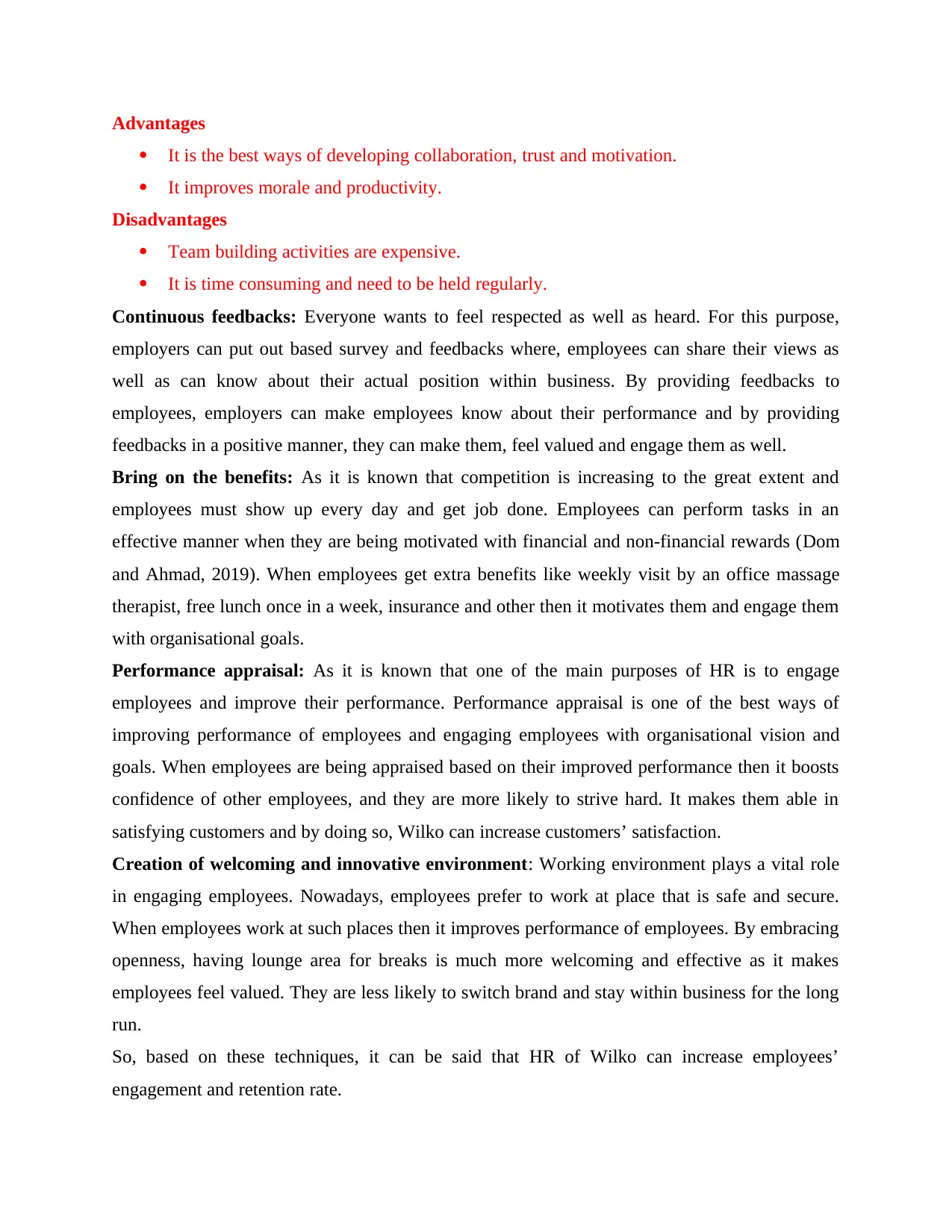
Advantages
It is the best ways of developing collaboration, trust and motivation.
It improves morale and productivity.
Disadvantages
Team building activities are expensive.
It is time consuming and need to be held regularly.
Continuous feedbacks: Everyone wants to feel respected as well as heard. For this purpose,
employers can put out based survey and feedbacks where, employees can share their views as
well as can know about their actual position within business. By providing feedbacks to
employees, employers can make employees know about their performance and by providing
feedbacks in a positive manner, they can make them, feel valued and engage them as well.
Bring on the benefits: As it is known that competition is increasing to the great extent and
employees must show up every day and get job done. Employees can perform tasks in an
effective manner when they are being motivated with financial and non-financial rewards (Dom
and Ahmad, 2019). When employees get extra benefits like weekly visit by an office massage
therapist, free lunch once in a week, insurance and other then it motivates them and engage them
with organisational goals.
Performance appraisal: As it is known that one of the main purposes of HR is to engage
employees and improve their performance. Performance appraisal is one of the best ways of
improving performance of employees and engaging employees with organisational vision and
goals. When employees are being appraised based on their improved performance then it boosts
confidence of other employees, and they are more likely to strive hard. It makes them able in
satisfying customers and by doing so, Wilko can increase customers’ satisfaction.
Creation of welcoming and innovative environment: Working environment plays a vital role
in engaging employees. Nowadays, employees prefer to work at place that is safe and secure.
When employees work at such places then it improves performance of employees. By embracing
openness, having lounge area for breaks is much more welcoming and effective as it makes
employees feel valued. They are less likely to switch brand and stay within business for the long
run.
So, based on these techniques, it can be said that HR of Wilko can increase employees’
engagement and retention rate.
It is the best ways of developing collaboration, trust and motivation.
It improves morale and productivity.
Disadvantages
Team building activities are expensive.
It is time consuming and need to be held regularly.
Continuous feedbacks: Everyone wants to feel respected as well as heard. For this purpose,
employers can put out based survey and feedbacks where, employees can share their views as
well as can know about their actual position within business. By providing feedbacks to
employees, employers can make employees know about their performance and by providing
feedbacks in a positive manner, they can make them, feel valued and engage them as well.
Bring on the benefits: As it is known that competition is increasing to the great extent and
employees must show up every day and get job done. Employees can perform tasks in an
effective manner when they are being motivated with financial and non-financial rewards (Dom
and Ahmad, 2019). When employees get extra benefits like weekly visit by an office massage
therapist, free lunch once in a week, insurance and other then it motivates them and engage them
with organisational goals.
Performance appraisal: As it is known that one of the main purposes of HR is to engage
employees and improve their performance. Performance appraisal is one of the best ways of
improving performance of employees and engaging employees with organisational vision and
goals. When employees are being appraised based on their improved performance then it boosts
confidence of other employees, and they are more likely to strive hard. It makes them able in
satisfying customers and by doing so, Wilko can increase customers’ satisfaction.
Creation of welcoming and innovative environment: Working environment plays a vital role
in engaging employees. Nowadays, employees prefer to work at place that is safe and secure.
When employees work at such places then it improves performance of employees. By embracing
openness, having lounge area for breaks is much more welcoming and effective as it makes
employees feel valued. They are less likely to switch brand and stay within business for the long
run.
So, based on these techniques, it can be said that HR of Wilko can increase employees’
engagement and retention rate.
Paraphrase This Document
Need a fresh take? Get an instant paraphrase of this document with our AI Paraphraser
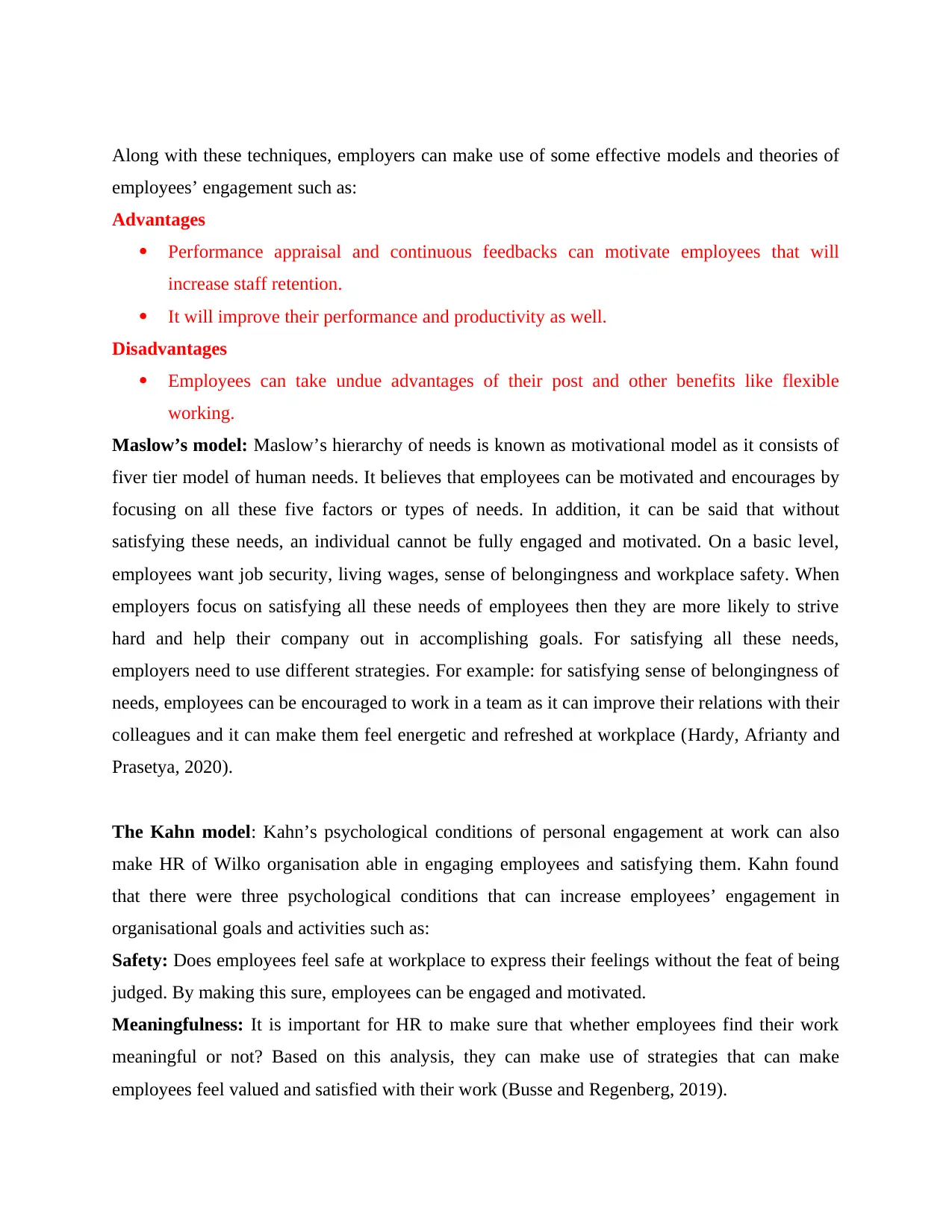
Along with these techniques, employers can make use of some effective models and theories of
employees’ engagement such as:
Advantages
Performance appraisal and continuous feedbacks can motivate employees that will
increase staff retention.
It will improve their performance and productivity as well.
Disadvantages
Employees can take undue advantages of their post and other benefits like flexible
working.
Maslow’s model: Maslow’s hierarchy of needs is known as motivational model as it consists of
fiver tier model of human needs. It believes that employees can be motivated and encourages by
focusing on all these five factors or types of needs. In addition, it can be said that without
satisfying these needs, an individual cannot be fully engaged and motivated. On a basic level,
employees want job security, living wages, sense of belongingness and workplace safety. When
employers focus on satisfying all these needs of employees then they are more likely to strive
hard and help their company out in accomplishing goals. For satisfying all these needs,
employers need to use different strategies. For example: for satisfying sense of belongingness of
needs, employees can be encouraged to work in a team as it can improve their relations with their
colleagues and it can make them feel energetic and refreshed at workplace (Hardy, Afrianty and
Prasetya, 2020).
The Kahn model: Kahn’s psychological conditions of personal engagement at work can also
make HR of Wilko organisation able in engaging employees and satisfying them. Kahn found
that there were three psychological conditions that can increase employees’ engagement in
organisational goals and activities such as:
Safety: Does employees feel safe at workplace to express their feelings without the feat of being
judged. By making this sure, employees can be engaged and motivated.
Meaningfulness: It is important for HR to make sure that whether employees find their work
meaningful or not? Based on this analysis, they can make use of strategies that can make
employees feel valued and satisfied with their work (Busse and Regenberg, 2019).
employees’ engagement such as:
Advantages
Performance appraisal and continuous feedbacks can motivate employees that will
increase staff retention.
It will improve their performance and productivity as well.
Disadvantages
Employees can take undue advantages of their post and other benefits like flexible
working.
Maslow’s model: Maslow’s hierarchy of needs is known as motivational model as it consists of
fiver tier model of human needs. It believes that employees can be motivated and encourages by
focusing on all these five factors or types of needs. In addition, it can be said that without
satisfying these needs, an individual cannot be fully engaged and motivated. On a basic level,
employees want job security, living wages, sense of belongingness and workplace safety. When
employers focus on satisfying all these needs of employees then they are more likely to strive
hard and help their company out in accomplishing goals. For satisfying all these needs,
employers need to use different strategies. For example: for satisfying sense of belongingness of
needs, employees can be encouraged to work in a team as it can improve their relations with their
colleagues and it can make them feel energetic and refreshed at workplace (Hardy, Afrianty and
Prasetya, 2020).
The Kahn model: Kahn’s psychological conditions of personal engagement at work can also
make HR of Wilko organisation able in engaging employees and satisfying them. Kahn found
that there were three psychological conditions that can increase employees’ engagement in
organisational goals and activities such as:
Safety: Does employees feel safe at workplace to express their feelings without the feat of being
judged. By making this sure, employees can be engaged and motivated.
Meaningfulness: It is important for HR to make sure that whether employees find their work
meaningful or not? Based on this analysis, they can make use of strategies that can make
employees feel valued and satisfied with their work (Busse and Regenberg, 2019).
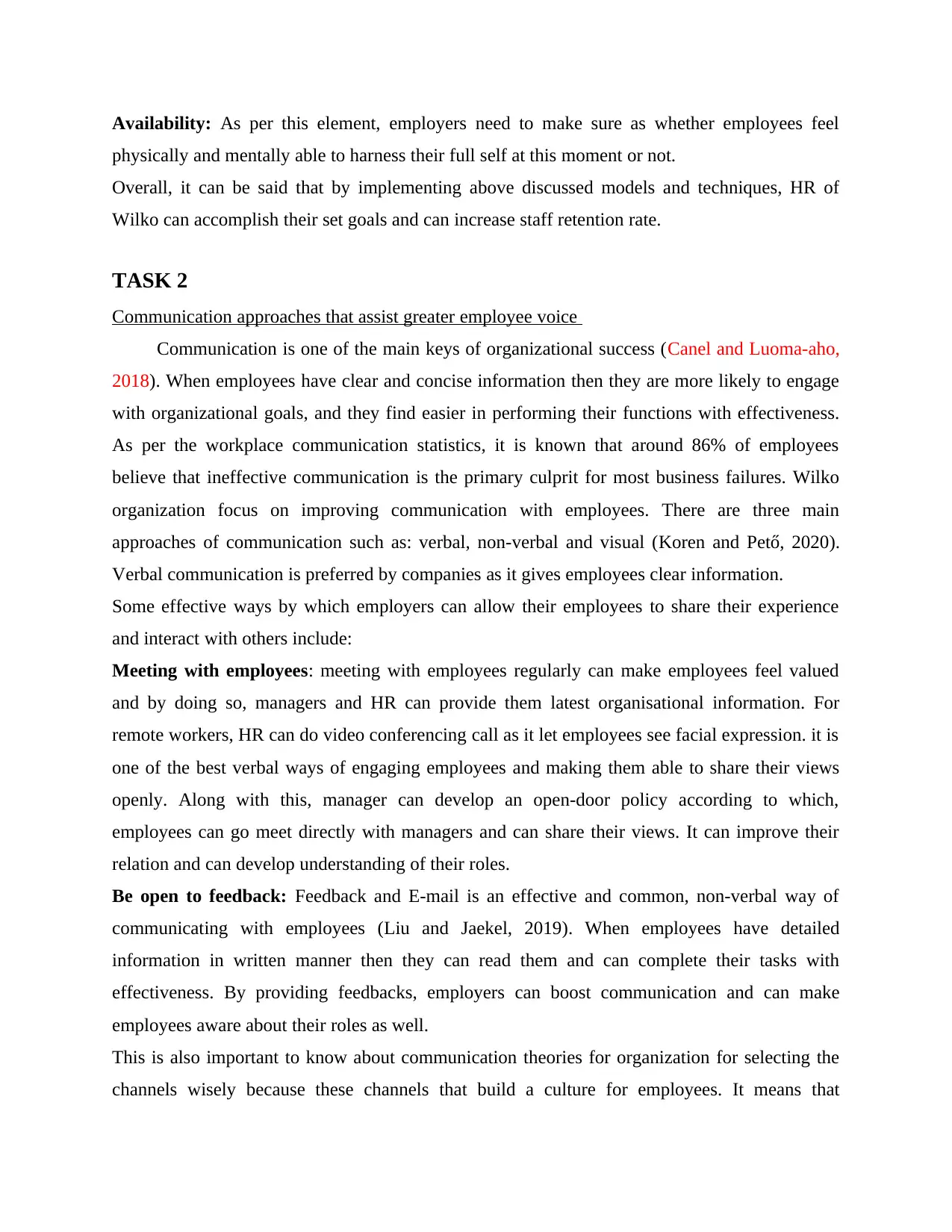
Availability: As per this element, employers need to make sure as whether employees feel
physically and mentally able to harness their full self at this moment or not.
Overall, it can be said that by implementing above discussed models and techniques, HR of
Wilko can accomplish their set goals and can increase staff retention rate.
TASK 2
Communication approaches that assist greater employee voice
Communication is one of the main keys of organizational success (Canel and Luoma-aho,
2018). When employees have clear and concise information then they are more likely to engage
with organizational goals, and they find easier in performing their functions with effectiveness.
As per the workplace communication statistics, it is known that around 86% of employees
believe that ineffective communication is the primary culprit for most business failures. Wilko
organization focus on improving communication with employees. There are three main
approaches of communication such as: verbal, non-verbal and visual (Koren and Pető, 2020).
Verbal communication is preferred by companies as it gives employees clear information.
Some effective ways by which employers can allow their employees to share their experience
and interact with others include:
Meeting with employees: meeting with employees regularly can make employees feel valued
and by doing so, managers and HR can provide them latest organisational information. For
remote workers, HR can do video conferencing call as it let employees see facial expression. it is
one of the best verbal ways of engaging employees and making them able to share their views
openly. Along with this, manager can develop an open-door policy according to which,
employees can go meet directly with managers and can share their views. It can improve their
relation and can develop understanding of their roles.
Be open to feedback: Feedback and E-mail is an effective and common, non-verbal way of
communicating with employees (Liu and Jaekel, 2019). When employees have detailed
information in written manner then they can read them and can complete their tasks with
effectiveness. By providing feedbacks, employers can boost communication and can make
employees aware about their roles as well.
This is also important to know about communication theories for organization for selecting the
channels wisely because these channels that build a culture for employees. It means that
physically and mentally able to harness their full self at this moment or not.
Overall, it can be said that by implementing above discussed models and techniques, HR of
Wilko can accomplish their set goals and can increase staff retention rate.
TASK 2
Communication approaches that assist greater employee voice
Communication is one of the main keys of organizational success (Canel and Luoma-aho,
2018). When employees have clear and concise information then they are more likely to engage
with organizational goals, and they find easier in performing their functions with effectiveness.
As per the workplace communication statistics, it is known that around 86% of employees
believe that ineffective communication is the primary culprit for most business failures. Wilko
organization focus on improving communication with employees. There are three main
approaches of communication such as: verbal, non-verbal and visual (Koren and Pető, 2020).
Verbal communication is preferred by companies as it gives employees clear information.
Some effective ways by which employers can allow their employees to share their experience
and interact with others include:
Meeting with employees: meeting with employees regularly can make employees feel valued
and by doing so, managers and HR can provide them latest organisational information. For
remote workers, HR can do video conferencing call as it let employees see facial expression. it is
one of the best verbal ways of engaging employees and making them able to share their views
openly. Along with this, manager can develop an open-door policy according to which,
employees can go meet directly with managers and can share their views. It can improve their
relation and can develop understanding of their roles.
Be open to feedback: Feedback and E-mail is an effective and common, non-verbal way of
communicating with employees (Liu and Jaekel, 2019). When employees have detailed
information in written manner then they can read them and can complete their tasks with
effectiveness. By providing feedbacks, employers can boost communication and can make
employees aware about their roles as well.
This is also important to know about communication theories for organization for selecting the
channels wisely because these channels that build a culture for employees. It means that
⊘ This is a preview!⊘
Do you want full access?
Subscribe today to unlock all pages.

Trusted by 1+ million students worldwide
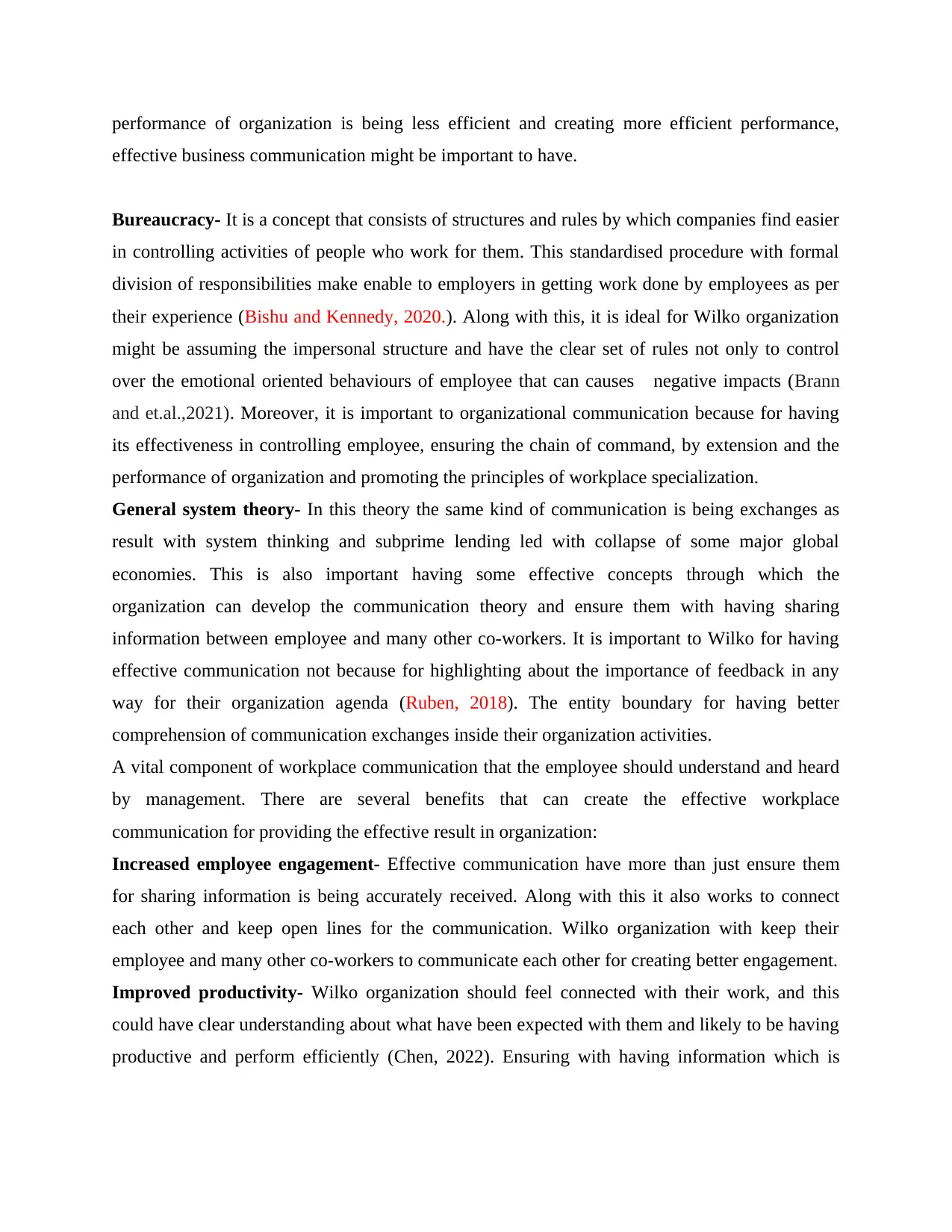
performance of organization is being less efficient and creating more efficient performance,
effective business communication might be important to have.
Bureaucracy- It is a concept that consists of structures and rules by which companies find easier
in controlling activities of people who work for them. This standardised procedure with formal
division of responsibilities make enable to employers in getting work done by employees as per
their experience (Bishu and Kennedy, 2020.). Along with this, it is ideal for Wilko organization
might be assuming the impersonal structure and have the clear set of rules not only to control
over the emotional oriented behaviours of employee that can causes negative impacts (Brann
and et.al.,2021). Moreover, it is important to organizational communication because for having
its effectiveness in controlling employee, ensuring the chain of command, by extension and the
performance of organization and promoting the principles of workplace specialization.
General system theory- In this theory the same kind of communication is being exchanges as
result with system thinking and subprime lending led with collapse of some major global
economies. This is also important having some effective concepts through which the
organization can develop the communication theory and ensure them with having sharing
information between employee and many other co-workers. It is important to Wilko for having
effective communication not because for highlighting about the importance of feedback in any
way for their organization agenda (Ruben, 2018). The entity boundary for having better
comprehension of communication exchanges inside their organization activities.
A vital component of workplace communication that the employee should understand and heard
by management. There are several benefits that can create the effective workplace
communication for providing the effective result in organization:
Increased employee engagement- Effective communication have more than just ensure them
for sharing information is being accurately received. Along with this it also works to connect
each other and keep open lines for the communication. Wilko organization with keep their
employee and many other co-workers to communicate each other for creating better engagement.
Improved productivity- Wilko organization should feel connected with their work, and this
could have clear understanding about what have been expected with them and likely to be having
productive and perform efficiently (Chen, 2022). Ensuring with having information which is
effective business communication might be important to have.
Bureaucracy- It is a concept that consists of structures and rules by which companies find easier
in controlling activities of people who work for them. This standardised procedure with formal
division of responsibilities make enable to employers in getting work done by employees as per
their experience (Bishu and Kennedy, 2020.). Along with this, it is ideal for Wilko organization
might be assuming the impersonal structure and have the clear set of rules not only to control
over the emotional oriented behaviours of employee that can causes negative impacts (Brann
and et.al.,2021). Moreover, it is important to organizational communication because for having
its effectiveness in controlling employee, ensuring the chain of command, by extension and the
performance of organization and promoting the principles of workplace specialization.
General system theory- In this theory the same kind of communication is being exchanges as
result with system thinking and subprime lending led with collapse of some major global
economies. This is also important having some effective concepts through which the
organization can develop the communication theory and ensure them with having sharing
information between employee and many other co-workers. It is important to Wilko for having
effective communication not because for highlighting about the importance of feedback in any
way for their organization agenda (Ruben, 2018). The entity boundary for having better
comprehension of communication exchanges inside their organization activities.
A vital component of workplace communication that the employee should understand and heard
by management. There are several benefits that can create the effective workplace
communication for providing the effective result in organization:
Increased employee engagement- Effective communication have more than just ensure them
for sharing information is being accurately received. Along with this it also works to connect
each other and keep open lines for the communication. Wilko organization with keep their
employee and many other co-workers to communicate each other for creating better engagement.
Improved productivity- Wilko organization should feel connected with their work, and this
could have clear understanding about what have been expected with them and likely to be having
productive and perform efficiently (Chen, 2022). Ensuring with having information which is
Paraphrase This Document
Need a fresh take? Get an instant paraphrase of this document with our AI Paraphraser

being available and communication with an effective manner that allows the employee with
better performance and can increase productivity throughout the organization.
Improved direction for employees- Open communication at the workplace ensure about that
employee need to understand the best part of their company and have clear direction in terms as
what have been expected.
TASK 3
Training and development consideration in business to enhance both manager and employees.
Training and development refer to the educational activities with Wilko for creating enhance
about the knowledge and skills of employee while providing information and instruction on how
to perform with better tasks. Along with this training lead with having short terms process for
operative and process while development in designing continuous pro-active process meant for
organization. In training the employee has aim for developing some additional skills and
development for some total personality. Employee training and development which helps in
updating employee’s knowledge and skills for performing job that could result at end with
increasing their work efficiency and increase the productivity of organization (Gratton, 2018). It
has been found from outcomes of successful companies that the reason behind staff retention and
their success is: investment in training and development programs.
It is also important to polish out the skills and bring out the valuable assets for organization with
some possible way to build the workforce with training and development. Line manager who
plays critical role in employee engagement through having some interpersonal relationships with
employees. This could keep interested and connected with every team member that will foster
engaged with culture where the employee is being committed and willing to perform, they are
beyond expectation. Sustainable employee engagement is being driven with huge factor and one
of the most important influences about the relationships between employee and their direct line
manager (Kreismann and Talaulicar, 2021). This could often the variable dynamics because the
front-line manager is being promoted within organization and this may have no formal
management training about how to get the best out of their team.
A discussion of major theories of training and development:
Theory of reinforcement- This theory discusses the effective learning behaviour of employee
and suggest that learner will repeat with having same behaviour in attachment with positive
outcomes or better result. It could be suggested the training and development program which
better performance and can increase productivity throughout the organization.
Improved direction for employees- Open communication at the workplace ensure about that
employee need to understand the best part of their company and have clear direction in terms as
what have been expected.
TASK 3
Training and development consideration in business to enhance both manager and employees.
Training and development refer to the educational activities with Wilko for creating enhance
about the knowledge and skills of employee while providing information and instruction on how
to perform with better tasks. Along with this training lead with having short terms process for
operative and process while development in designing continuous pro-active process meant for
organization. In training the employee has aim for developing some additional skills and
development for some total personality. Employee training and development which helps in
updating employee’s knowledge and skills for performing job that could result at end with
increasing their work efficiency and increase the productivity of organization (Gratton, 2018). It
has been found from outcomes of successful companies that the reason behind staff retention and
their success is: investment in training and development programs.
It is also important to polish out the skills and bring out the valuable assets for organization with
some possible way to build the workforce with training and development. Line manager who
plays critical role in employee engagement through having some interpersonal relationships with
employees. This could keep interested and connected with every team member that will foster
engaged with culture where the employee is being committed and willing to perform, they are
beyond expectation. Sustainable employee engagement is being driven with huge factor and one
of the most important influences about the relationships between employee and their direct line
manager (Kreismann and Talaulicar, 2021). This could often the variable dynamics because the
front-line manager is being promoted within organization and this may have no formal
management training about how to get the best out of their team.
A discussion of major theories of training and development:
Theory of reinforcement- This theory discusses the effective learning behaviour of employee
and suggest that learner will repeat with having same behaviour in attachment with positive
outcomes or better result. It could be suggested the training and development program which
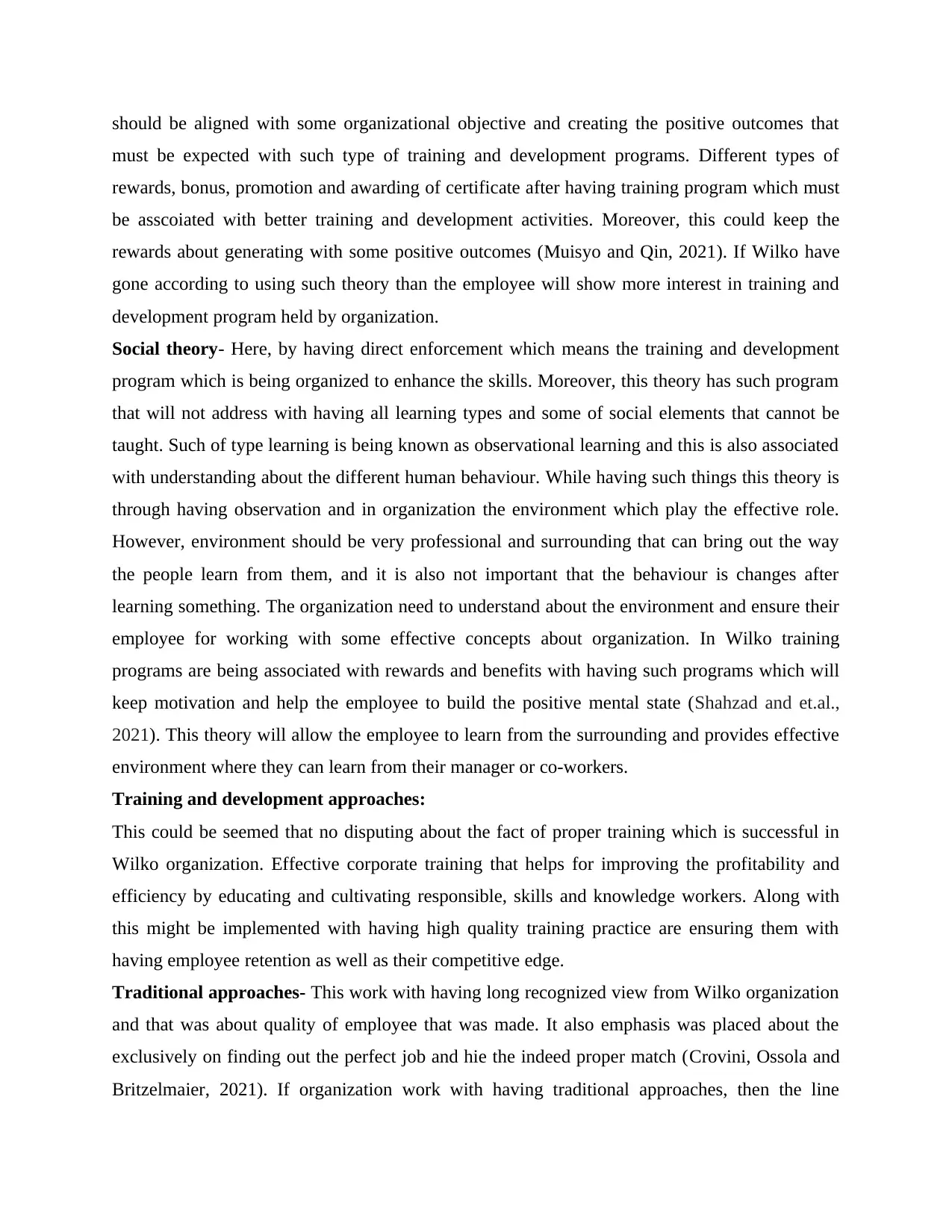
should be aligned with some organizational objective and creating the positive outcomes that
must be expected with such type of training and development programs. Different types of
rewards, bonus, promotion and awarding of certificate after having training program which must
be asscoiated with better training and development activities. Moreover, this could keep the
rewards about generating with some positive outcomes (Muisyo and Qin, 2021). If Wilko have
gone according to using such theory than the employee will show more interest in training and
development program held by organization.
Social theory- Here, by having direct enforcement which means the training and development
program which is being organized to enhance the skills. Moreover, this theory has such program
that will not address with having all learning types and some of social elements that cannot be
taught. Such of type learning is being known as observational learning and this is also associated
with understanding about the different human behaviour. While having such things this theory is
through having observation and in organization the environment which play the effective role.
However, environment should be very professional and surrounding that can bring out the way
the people learn from them, and it is also not important that the behaviour is changes after
learning something. The organization need to understand about the environment and ensure their
employee for working with some effective concepts about organization. In Wilko training
programs are being associated with rewards and benefits with having such programs which will
keep motivation and help the employee to build the positive mental state (Shahzad and et.al.,
2021). This theory will allow the employee to learn from the surrounding and provides effective
environment where they can learn from their manager or co-workers.
Training and development approaches:
This could be seemed that no disputing about the fact of proper training which is successful in
Wilko organization. Effective corporate training that helps for improving the profitability and
efficiency by educating and cultivating responsible, skills and knowledge workers. Along with
this might be implemented with having high quality training practice are ensuring them with
having employee retention as well as their competitive edge.
Traditional approaches- This work with having long recognized view from Wilko organization
and that was about quality of employee that was made. It also emphasis was placed about the
exclusively on finding out the perfect job and hie the indeed proper match (Crovini, Ossola and
Britzelmaier, 2021). If organization work with having traditional approaches, then the line
must be expected with such type of training and development programs. Different types of
rewards, bonus, promotion and awarding of certificate after having training program which must
be asscoiated with better training and development activities. Moreover, this could keep the
rewards about generating with some positive outcomes (Muisyo and Qin, 2021). If Wilko have
gone according to using such theory than the employee will show more interest in training and
development program held by organization.
Social theory- Here, by having direct enforcement which means the training and development
program which is being organized to enhance the skills. Moreover, this theory has such program
that will not address with having all learning types and some of social elements that cannot be
taught. Such of type learning is being known as observational learning and this is also associated
with understanding about the different human behaviour. While having such things this theory is
through having observation and in organization the environment which play the effective role.
However, environment should be very professional and surrounding that can bring out the way
the people learn from them, and it is also not important that the behaviour is changes after
learning something. The organization need to understand about the environment and ensure their
employee for working with some effective concepts about organization. In Wilko training
programs are being associated with rewards and benefits with having such programs which will
keep motivation and help the employee to build the positive mental state (Shahzad and et.al.,
2021). This theory will allow the employee to learn from the surrounding and provides effective
environment where they can learn from their manager or co-workers.
Training and development approaches:
This could be seemed that no disputing about the fact of proper training which is successful in
Wilko organization. Effective corporate training that helps for improving the profitability and
efficiency by educating and cultivating responsible, skills and knowledge workers. Along with
this might be implemented with having high quality training practice are ensuring them with
having employee retention as well as their competitive edge.
Traditional approaches- This work with having long recognized view from Wilko organization
and that was about quality of employee that was made. It also emphasis was placed about the
exclusively on finding out the perfect job and hie the indeed proper match (Crovini, Ossola and
Britzelmaier, 2021). If organization work with having traditional approaches, then the line
⊘ This is a preview!⊘
Do you want full access?
Subscribe today to unlock all pages.

Trusted by 1+ million students worldwide
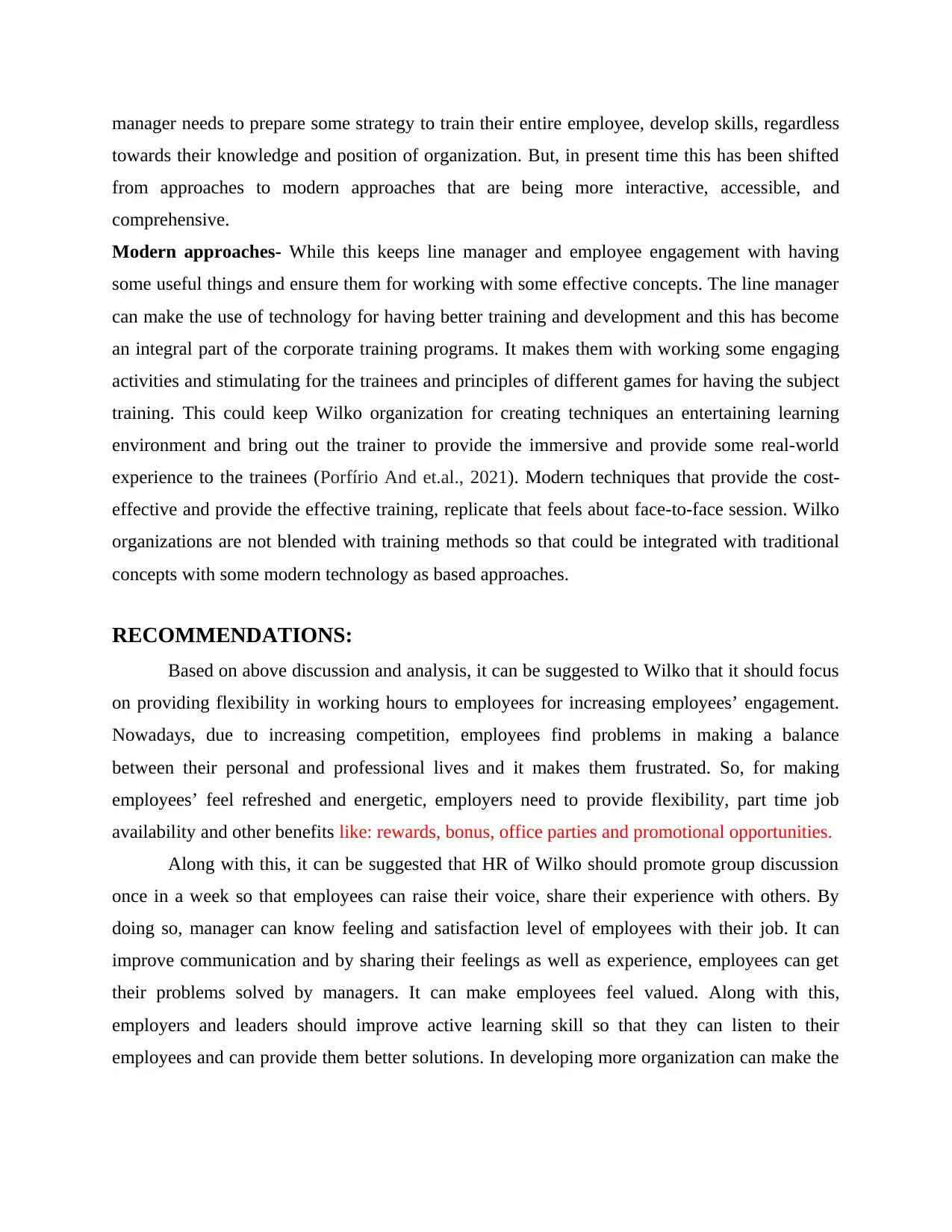
manager needs to prepare some strategy to train their entire employee, develop skills, regardless
towards their knowledge and position of organization. But, in present time this has been shifted
from approaches to modern approaches that are being more interactive, accessible, and
comprehensive.
Modern approaches- While this keeps line manager and employee engagement with having
some useful things and ensure them for working with some effective concepts. The line manager
can make the use of technology for having better training and development and this has become
an integral part of the corporate training programs. It makes them with working some engaging
activities and stimulating for the trainees and principles of different games for having the subject
training. This could keep Wilko organization for creating techniques an entertaining learning
environment and bring out the trainer to provide the immersive and provide some real-world
experience to the trainees (Porfírio And et.al., 2021). Modern techniques that provide the cost-
effective and provide the effective training, replicate that feels about face-to-face session. Wilko
organizations are not blended with training methods so that could be integrated with traditional
concepts with some modern technology as based approaches.
RECOMMENDATIONS:
Based on above discussion and analysis, it can be suggested to Wilko that it should focus
on providing flexibility in working hours to employees for increasing employees’ engagement.
Nowadays, due to increasing competition, employees find problems in making a balance
between their personal and professional lives and it makes them frustrated. So, for making
employees’ feel refreshed and energetic, employers need to provide flexibility, part time job
availability and other benefits like: rewards, bonus, office parties and promotional opportunities.
Along with this, it can be suggested that HR of Wilko should promote group discussion
once in a week so that employees can raise their voice, share their experience with others. By
doing so, manager can know feeling and satisfaction level of employees with their job. It can
improve communication and by sharing their feelings as well as experience, employees can get
their problems solved by managers. It can make employees feel valued. Along with this,
employers and leaders should improve active learning skill so that they can listen to their
employees and can provide them better solutions. In developing more organization can make the
towards their knowledge and position of organization. But, in present time this has been shifted
from approaches to modern approaches that are being more interactive, accessible, and
comprehensive.
Modern approaches- While this keeps line manager and employee engagement with having
some useful things and ensure them for working with some effective concepts. The line manager
can make the use of technology for having better training and development and this has become
an integral part of the corporate training programs. It makes them with working some engaging
activities and stimulating for the trainees and principles of different games for having the subject
training. This could keep Wilko organization for creating techniques an entertaining learning
environment and bring out the trainer to provide the immersive and provide some real-world
experience to the trainees (Porfírio And et.al., 2021). Modern techniques that provide the cost-
effective and provide the effective training, replicate that feels about face-to-face session. Wilko
organizations are not blended with training methods so that could be integrated with traditional
concepts with some modern technology as based approaches.
RECOMMENDATIONS:
Based on above discussion and analysis, it can be suggested to Wilko that it should focus
on providing flexibility in working hours to employees for increasing employees’ engagement.
Nowadays, due to increasing competition, employees find problems in making a balance
between their personal and professional lives and it makes them frustrated. So, for making
employees’ feel refreshed and energetic, employers need to provide flexibility, part time job
availability and other benefits like: rewards, bonus, office parties and promotional opportunities.
Along with this, it can be suggested that HR of Wilko should promote group discussion
once in a week so that employees can raise their voice, share their experience with others. By
doing so, manager can know feeling and satisfaction level of employees with their job. It can
improve communication and by sharing their feelings as well as experience, employees can get
their problems solved by managers. It can make employees feel valued. Along with this,
employers and leaders should improve active learning skill so that they can listen to their
employees and can provide them better solutions. In developing more organization can make the
Paraphrase This Document
Need a fresh take? Get an instant paraphrase of this document with our AI Paraphraser
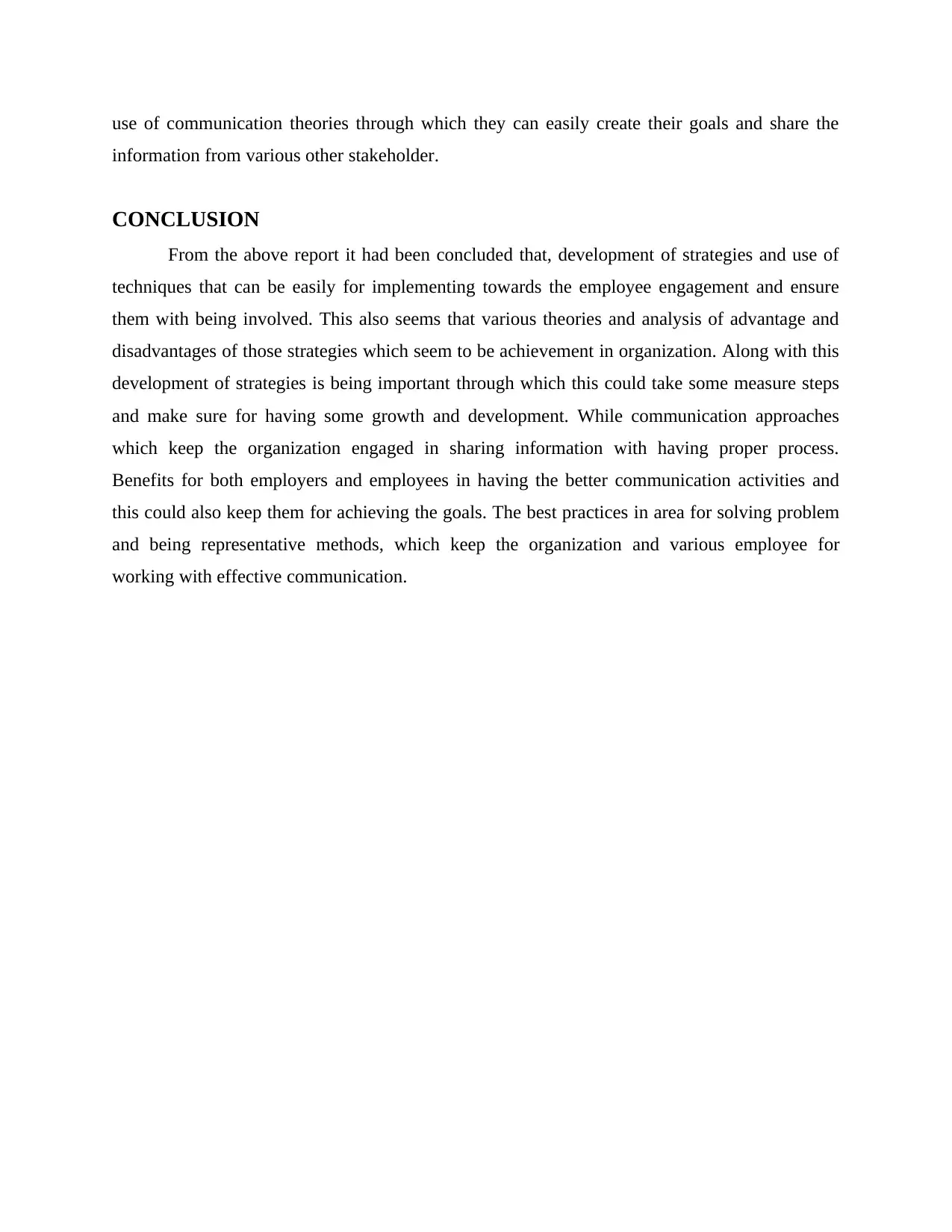
use of communication theories through which they can easily create their goals and share the
information from various other stakeholder.
CONCLUSION
From the above report it had been concluded that, development of strategies and use of
techniques that can be easily for implementing towards the employee engagement and ensure
them with being involved. This also seems that various theories and analysis of advantage and
disadvantages of those strategies which seem to be achievement in organization. Along with this
development of strategies is being important through which this could take some measure steps
and make sure for having some growth and development. While communication approaches
which keep the organization engaged in sharing information with having proper process.
Benefits for both employers and employees in having the better communication activities and
this could also keep them for achieving the goals. The best practices in area for solving problem
and being representative methods, which keep the organization and various employee for
working with effective communication.
information from various other stakeholder.
CONCLUSION
From the above report it had been concluded that, development of strategies and use of
techniques that can be easily for implementing towards the employee engagement and ensure
them with being involved. This also seems that various theories and analysis of advantage and
disadvantages of those strategies which seem to be achievement in organization. Along with this
development of strategies is being important through which this could take some measure steps
and make sure for having some growth and development. While communication approaches
which keep the organization engaged in sharing information with having proper process.
Benefits for both employers and employees in having the better communication activities and
this could also keep them for achieving the goals. The best practices in area for solving problem
and being representative methods, which keep the organization and various employee for
working with effective communication.
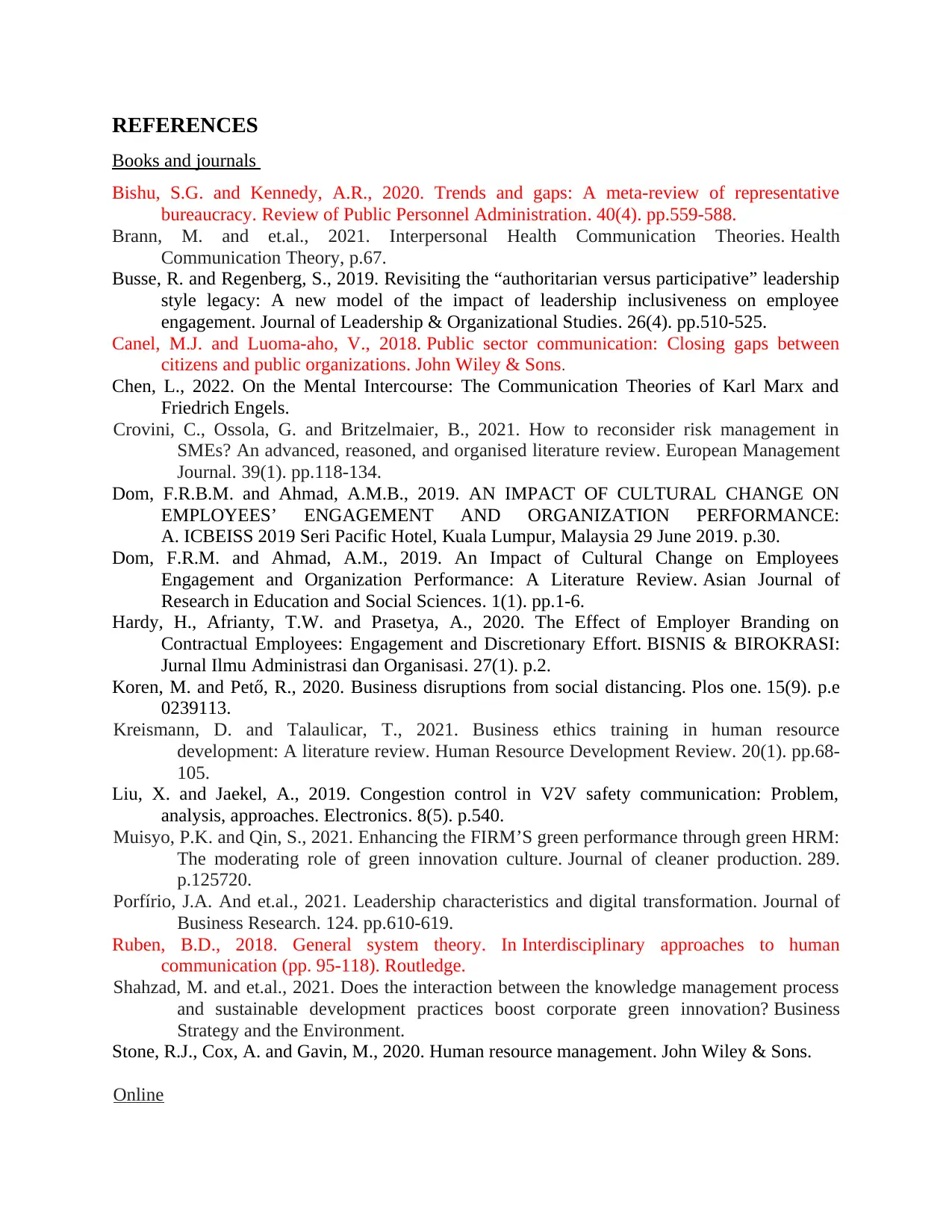
REFERENCES
Books and journals
Bishu, S.G. and Kennedy, A.R., 2020. Trends and gaps: A meta-review of representative
bureaucracy. Review of Public Personnel Administration. 40(4). pp.559-588.
Brann, M. and et.al., 2021. Interpersonal Health Communication Theories. Health
Communication Theory, p.67.
Busse, R. and Regenberg, S., 2019. Revisiting the “authoritarian versus participative” leadership
style legacy: A new model of the impact of leadership inclusiveness on employee
engagement. Journal of Leadership & Organizational Studies. 26(4). pp.510-525.
Canel, M.J. and Luoma-aho, V., 2018. Public sector communication: Closing gaps between
citizens and public organizations. John Wiley & Sons.
Chen, L., 2022. On the Mental Intercourse: The Communication Theories of Karl Marx and
Friedrich Engels.
Crovini, C., Ossola, G. and Britzelmaier, B., 2021. How to reconsider risk management in
SMEs? An advanced, reasoned, and organised literature review. European Management
Journal. 39(1). pp.118-134.
Dom, F.R.B.M. and Ahmad, A.M.B., 2019. AN IMPACT OF CULTURAL CHANGE ON
EMPLOYEES’ ENGAGEMENT AND ORGANIZATION PERFORMANCE:
A. ICBEISS 2019 Seri Pacific Hotel, Kuala Lumpur, Malaysia 29 June 2019. p.30.
Dom, F.R.M. and Ahmad, A.M., 2019. An Impact of Cultural Change on Employees
Engagement and Organization Performance: A Literature Review. Asian Journal of
Research in Education and Social Sciences. 1(1). pp.1-6.
Hardy, H., Afrianty, T.W. and Prasetya, A., 2020. The Effect of Employer Branding on
Contractual Employees: Engagement and Discretionary Effort. BISNIS & BIROKRASI:
Jurnal Ilmu Administrasi dan Organisasi. 27(1). p.2.
Koren, M. and Pető, R., 2020. Business disruptions from social distancing. Plos one. 15(9). p.e
0239113.
Kreismann, D. and Talaulicar, T., 2021. Business ethics training in human resource
development: A literature review. Human Resource Development Review. 20(1). pp.68-
105.
Liu, X. and Jaekel, A., 2019. Congestion control in V2V safety communication: Problem,
analysis, approaches. Electronics. 8(5). p.540.
Muisyo, P.K. and Qin, S., 2021. Enhancing the FIRM’S green performance through green HRM:
The moderating role of green innovation culture. Journal of cleaner production. 289.
p.125720.
Porfírio, J.A. And et.al., 2021. Leadership characteristics and digital transformation. Journal of
Business Research. 124. pp.610-619.
Ruben, B.D., 2018. General system theory. In Interdisciplinary approaches to human
communication (pp. 95-118). Routledge.
Shahzad, M. and et.al., 2021. Does the interaction between the knowledge management process
and sustainable development practices boost corporate green innovation? Business
Strategy and the Environment.
Stone, R.J., Cox, A. and Gavin, M., 2020. Human resource management. John Wiley & Sons.
Online
Books and journals
Bishu, S.G. and Kennedy, A.R., 2020. Trends and gaps: A meta-review of representative
bureaucracy. Review of Public Personnel Administration. 40(4). pp.559-588.
Brann, M. and et.al., 2021. Interpersonal Health Communication Theories. Health
Communication Theory, p.67.
Busse, R. and Regenberg, S., 2019. Revisiting the “authoritarian versus participative” leadership
style legacy: A new model of the impact of leadership inclusiveness on employee
engagement. Journal of Leadership & Organizational Studies. 26(4). pp.510-525.
Canel, M.J. and Luoma-aho, V., 2018. Public sector communication: Closing gaps between
citizens and public organizations. John Wiley & Sons.
Chen, L., 2022. On the Mental Intercourse: The Communication Theories of Karl Marx and
Friedrich Engels.
Crovini, C., Ossola, G. and Britzelmaier, B., 2021. How to reconsider risk management in
SMEs? An advanced, reasoned, and organised literature review. European Management
Journal. 39(1). pp.118-134.
Dom, F.R.B.M. and Ahmad, A.M.B., 2019. AN IMPACT OF CULTURAL CHANGE ON
EMPLOYEES’ ENGAGEMENT AND ORGANIZATION PERFORMANCE:
A. ICBEISS 2019 Seri Pacific Hotel, Kuala Lumpur, Malaysia 29 June 2019. p.30.
Dom, F.R.M. and Ahmad, A.M., 2019. An Impact of Cultural Change on Employees
Engagement and Organization Performance: A Literature Review. Asian Journal of
Research in Education and Social Sciences. 1(1). pp.1-6.
Hardy, H., Afrianty, T.W. and Prasetya, A., 2020. The Effect of Employer Branding on
Contractual Employees: Engagement and Discretionary Effort. BISNIS & BIROKRASI:
Jurnal Ilmu Administrasi dan Organisasi. 27(1). p.2.
Koren, M. and Pető, R., 2020. Business disruptions from social distancing. Plos one. 15(9). p.e
0239113.
Kreismann, D. and Talaulicar, T., 2021. Business ethics training in human resource
development: A literature review. Human Resource Development Review. 20(1). pp.68-
105.
Liu, X. and Jaekel, A., 2019. Congestion control in V2V safety communication: Problem,
analysis, approaches. Electronics. 8(5). p.540.
Muisyo, P.K. and Qin, S., 2021. Enhancing the FIRM’S green performance through green HRM:
The moderating role of green innovation culture. Journal of cleaner production. 289.
p.125720.
Porfírio, J.A. And et.al., 2021. Leadership characteristics and digital transformation. Journal of
Business Research. 124. pp.610-619.
Ruben, B.D., 2018. General system theory. In Interdisciplinary approaches to human
communication (pp. 95-118). Routledge.
Shahzad, M. and et.al., 2021. Does the interaction between the knowledge management process
and sustainable development practices boost corporate green innovation? Business
Strategy and the Environment.
Stone, R.J., Cox, A. and Gavin, M., 2020. Human resource management. John Wiley & Sons.
Online
⊘ This is a preview!⊘
Do you want full access?
Subscribe today to unlock all pages.

Trusted by 1+ million students worldwide
1 out of 13
Related Documents
Your All-in-One AI-Powered Toolkit for Academic Success.
+13062052269
info@desklib.com
Available 24*7 on WhatsApp / Email
![[object Object]](/_next/static/media/star-bottom.7253800d.svg)
Unlock your academic potential
Copyright © 2020–2025 A2Z Services. All Rights Reserved. Developed and managed by ZUCOL.





